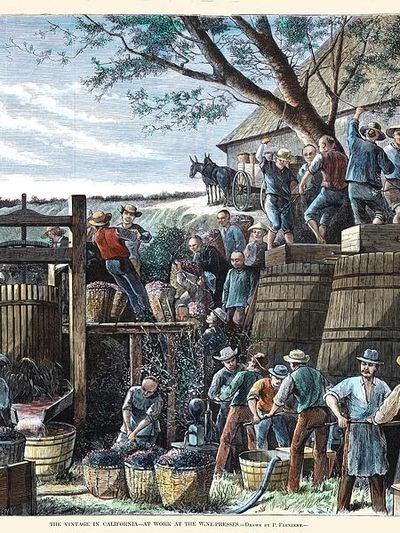California Wine History & Industry

The California wine industry literally put down its roots in 1769, when Padre Junipero Serra began his chain of missions in San Diego by planting grape seeds and vines. Eventually it stretched to Sonoma, more than 650 miles to the north.
The California wine industry owes its success to many fathers. One was a key vigneron, Jean-Louis Vignes, who established vineyards near what is now Los Angeles in 1834 and began the commercial wine industry.
The California wine industry began to really take shape in the early 1900s. By the mid-19th century, California was producing millions of gallons of wine per year and was the largest wine producer in the United States until two disasters struck.
The first was an infestation of phylloxera, the louse that attacks vine roots, which by 1915 destroyed 250,000 acres of California vineyards. Then, in 1919, Prohibition was enacted, outlawing the manufacture, transportation, sale, and possession of alcoholic beverages. Hundreds of California wineries were forced to close. By the time Prohibition was repealed in 1933, most wineries were in sad shape, having been neglected for years.
The University of California played a major role in moving the rekindled industry to quality, defining climate zones for growing fine wine grapes and establishing strict sanitation and quality production standards for the state’s wineries.
In the 1960s, the California wine industry began to lay the foundation for a surge in wine sales and the industry received a boost in 1976 when a FrancoCalifornian blind tasting was held in Paris to commemorate the U.S. Bicentennial.
To the surprise of everyone—especially the French—two upstart wineries from the Napa Valley finished in first place. The tasting, known as “The Judgment of Paris,” triggered an avalanche of global publicity for California wine, even prompting some French winemakers to join forces with or buy California properties.
Several other trends soon emerged to shape the market further. The move toward cooler climates proved as important as the recognition that controlling crop yields, using natural winemaking techniques, and fermenting wines in toasty oak barrels would lead to finer, more complex wines.
The spread of skilled California winemakers, with their varied tastes and inspirations, meant that a broad spectrum of wine styles—from elegant and finely structured to powerful and fruit-filled—would be made right there in the state.
The Modern Wine Industry

There are now more than 100 grape varieties grown in California, including a mix of the most popular French, Italian and Spanish grapes. Moreover, California wineries now produce all types of wine, including sparkling, dessert and fortified wines.
The primary focus, however, is on the “noble” grape varieties, including Cabernet Sauvignon, Merlot, Syrah, Pinot Noir, Chardonnay, Sauvignon Blanc and Riesling. In addition, other popular grape varieties include Zinfandel, Petite Sirah, Grenache, Mourvèdre, Malbec, Cabernet Franc, Roussanne, Nebbiolo and Sangiovese.
On a statewide basis, Cabernet Sauvignon and Chardonnay are the two most important grape varieties. Out of the total 525,000 acres planted in California, nearly 95,000 are dedicated to Chardonnay and 80,000 are dedicated to Cabernet Sauvignon. Interestingly, nearly one-quarter (25%) of all vineyards in the Golden State are dedicated to organic, biodynamic, and sustainable winemaking practices.
Today, California hosts some of the world's largest wine companies and its winegrowing regions span the entire state and reflect a diverse and distinctive mix of winegrape varieties in significantly different locations, or appellations. It is also home to a wide array of boutique wineries, some of which attract astronomical prices for their cult wines. Furthermore, California is the fourth leading wine producer in the world!
Whether through mass production or single-vineyard artisanal winemaking, California produces 90 percent of American-made wine. It also supplies more than 60 percent of all wine consumed in the country (with the rest shipped internationally). A record 211.9 million cases were produced in 2011.
Copyright © 2025 California Winery Guides - All Rights Reserved.
This website uses cookies.
We use cookies to analyze website traffic and optimize your website experience. By accepting our use of cookies, your data will be aggregated with all other user data.